BIRDS AS ART BULLETIN #214
500 IS LENS FOR SALE
101 REASONS TO JOIN THE POST X-MAS IPT
ABP vs ABP II VS DB
eFilm EXPRESS CARD (FOR THE NEWEST LAPTOPS)
ICELAND JUNE 2007
KENYA SEPTEMBER 2008
FRANZ LANTING LINK
500 IS LENS COVER
BREEZEBROWSER TIP
THANKSGIVING LUNCH
PAT FORD FLY-FISHING BOOK
LegCoatTM TRIPOD LEG COVERS
THANKSGIVING LUNCH
DELKIN e-FILM PRO COMPACT FLASH CARDS/CRAZY LOW PRICES
IPT UPDATES
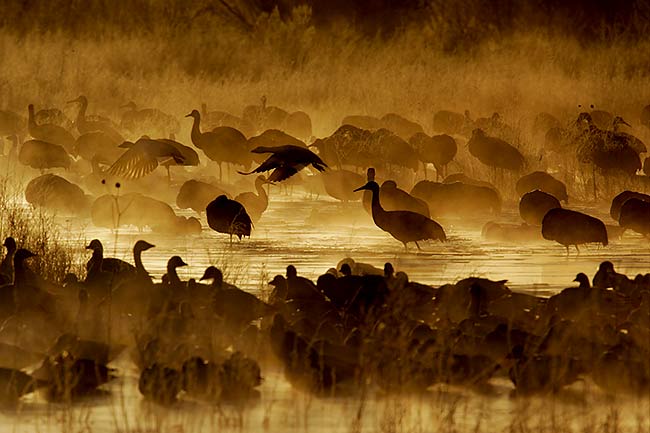
Sandhill Cranes & Snow Geese, Gold in the Mist, Bosque Del Apache NWR,
I underexposed to save most of the highlights in the water. Two tiny seed heads and some specular highlights were cloned out.
While going through 700gbs of images and deleting more than 200 gbs of digital junk I came across this image from Bosque last year and thought that it had some merit... I remember editing the images from this series and not being happy with any of them. I am glad that I re-considered this one. You need to look for ground fog on fairly open water and then wait for the sun to rise.
Due to one last minute cancellation and one disappearing act, we currently have two openings on the first Bosque IPT. Please e-mail (birdsasart@att.net) or call (863-692-0906) to learn of our Late Registration Discount.
Bosque #1: "The Fall Color IPT" NOV 14-16, 2006. 3-DAY: $929. Slide Program on the evening of NOV 13. (Two openings.) This IPT should offer the best chance for a day or two of the rare south winds that drastically improve flight photography and this IPT will definitely feature the brightest fall-color cottonwoods.
Bosque Site Guide: With the closing of the two crane pools on the west side of Highway 1, folks who have purchased the Bosque Site Guide (http://www.birdsasart.com/siteguides.htm#BOSQUE%20SITE%20GUIDE%20NOW%20AVAILABLE!) will be receiving a short update no later than November 21 outlining current conditions and my newest strategies.
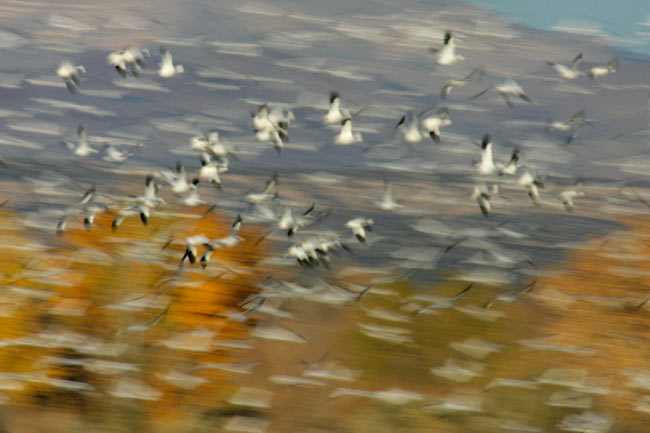
Snow Geese cottonwoods, Bosque Del Apache NWR,
Image copyright 2005: Arthur Morris/BIRDS AS ART
The first Bosque IPT will offer the best chance for incorporating fall color into the images. When using the 2X to create blurs of distant flocks, it is best to focus manually.
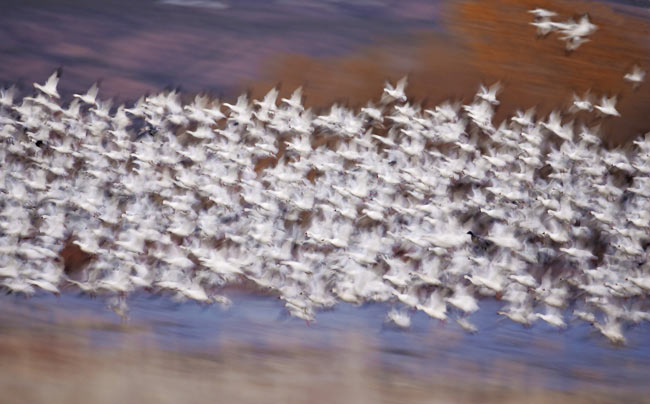
Snow Geese flock blur, Bosque Del Apache NWR,
Image copyright 2005: Arthur Morris/BIRDS AS ART
Notice that even at 1/8 second, the birds are rendered relatively sharp. This is because the birds are relatively far off. If you photographed a single goose flying by at close range at 1/8 second you would be left at best with a surrealistic mush… I have been corresponding with new Refuge Manager Tom Melanson who has been working on having the viewing windows re-cut to allow for easier viewing and for improved lines of sight for bird photography.
SHORT INTERVIEW
Patricio Murphy, of the Argentinean nature photography group Nature in Focus (http://www.naturalezaenfoco.com.ar), wrote requesting that I answer a few questions for an on-line interview. As the web site is in Spanish, I wanted to share what I wrote with you.
1. How was your interest in nature photography born, and how did you start? I saw the work of two local bird photographers and said, “I can do that!” I was right. After birding for 7 years I got bored, so I bought the Canon 400mm f/4.5 manual focus lens and started crawling around in the mud at Jamaica Bay Wildlife Refuge in Queens, NY.
2. Both technically and while working in the field, what are the specific challenges that the nature photographer faces? I would say that making sharp images by using autofocus properly and keeping the lens steady is the greatest challenge, and that goes double when you are trying to create images depicting flight or action…
3- What skills must the nature photographer master? They need to master exposure, sharpness techniques, the use of flash, learning to get close to animals without scaring them away, and optimizing the images in Photoshop to name just a few. In addition they need to be able to design a pleasing image often in a fraction of a second… The best news is that all of those topics are covered in detail in my newest book, The Art of Bird Photography II (916 pages, 900+ images, on CD only). You can check out ABP II here: here: http://www.birdsasart.com/ABPII.htm. With photography, if you do just one thing wrong in the entire process, there is a good chance that the image will not make you happy…
4. What equipment do you consider indispensable for your particular style? I own and use both the Canon 500 and 600mm EF Image Stabilized lens often with the 1.4 or 2X II teleconverters. My favorite cameras are the EOS-1Ds Mark II and the EOS-1D Mark IIN. But lenses are only tools and often the longest lens is not the best tool; other lenses that I use often include the Canon 400 f/5.6L, the 300mm f/4L IS, the 70-200 f/2.8 IS L, the 24-105mm IS L zoom, and the 100-400 IS L zoom. And I am trying to learn how to create some new and different images with the 15mm fish-eye lens.
5. What are the most common mistakes that beginning nature photographers make? #1: Using a poor light angle by not having their shadow point directly at the subject (when creating front lit images). #2: Using sloppy sharpness techniques that result in unsharp images. #3: Not considering the head angle of the subject and the alignment of the bird’s body to the imaging sensor (or film plane).
6. When photographing, what do you look for in your subject and your way of approaching it in order to make the picture both a faithful reproduction of the subject and a piece of art? First I try to find an attractive subject, one that is not in heavy molt or dirty. I evaluate the quality of light very carefully. Since the advent of digital I like cloudy conditions as much as early morning or late afternoon light. Then I do everything in my power to assure a distant background as this is the most important factor in creating the soft, out-of-focus backgrounds that are the hallmark of my clean, tight, graphic style. Again, all of these topics (and lots more) are covered in ABP II <smile>
7. Finally, a question you probably are tired of answering... What advice would you give to the beginning nature photographer? Photograph what you love and point your shadow at the subject. Get out into the field as often as possible. Do the work: study, learn, and look at as many great images as you can every day. And lastly, work as hard as humanly possible.
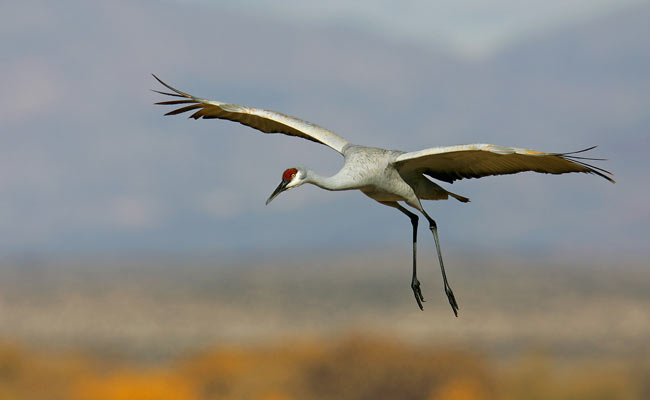
Sandhill Crane, Bosque Del Apache NWR,
With the crane pools closed, the best chances for photographing cranes in flight will most likely be at the farm fields. With “wind and sun together,” south or southeast winds in morning create the most favorable conditions.
101 REASONS TO JOIN THE POST X-MAS IPT
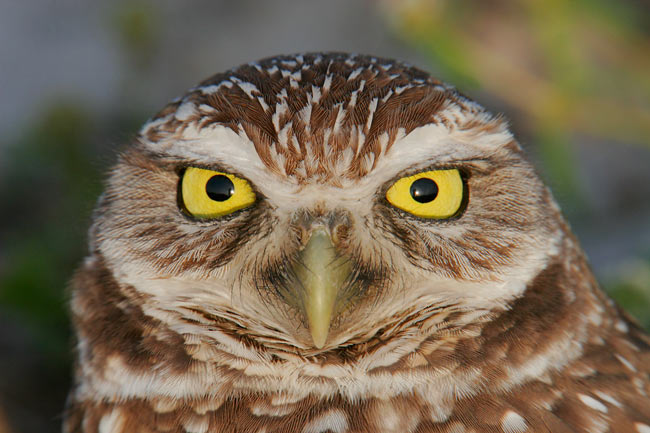
Burrowing Owl,
Image copyright 2006: Arthur Morris/BIRDS AS ART
We receive e-mails almost daily asking about the merits and the specifics of the original “The Art of Bird Photography; The Complete Guide to Professional Field Techniques (now in soft cover),” The Art of Bird Photography II (on CD only), and our Digital Basics File (a DPF sent via e-mail.) To clear up any confusion, I offer the following:
In January 2003, I began work on “The Art of Bird Photography II” (ABP II). “The Art of Bird Photography II is an all-new continuation of the original “The Art of Bird Photography; The Complete Guide to Professional Field Techniques.” At 916 pages with more than 900 images, ABP II is available only on CD. One chapter covers all aspects of Digital Photography and includes a section on understanding histograms. It also includes our complete digital workflow along with tons of great Photoshop tips. Other chapters include "Equipment; What's New?," "Advanced Composition and Image Design," "It Ain't Just Birds," and "Advanced Sharpness Techniques & Creating Pleasing Blurs." The "Practicalities" chapter will include a detailed section on setting up your backyard for bird photography as well as sections on photographing on safari and on the tundra. In addition it covers the every day aspects of handling and transporting your equipment from setting up your tripod to packing and traveling by air with your gear. Nearly all of the images in the book include all the technical data as well as our legendary educational captions. Most chapters include one or more galleries designed to illustrate and reinforce the principles covered in the text. There are two copies of the book on the CD. The "Spreads" version is best if you would like to enjoy the beauty of the images and the layout and design. The "Single Pages" version was designed for easy reading. The "Exposure and Flash Simplified" chapter re-visits two subjects that give folks the most trouble. Since the publication of ABP in 1998 we have refined and simplified our teaching in these two areas and these new approaches are covered in this all-new material. “Is the sun in or out? What is the overall tonality of the scene? When the sun is out at full strength your evaluative or matrix meter is smart. When it is cloudy, the same meter is dumb and needs your help. In addition to teaching this new approach to exposure the section on flash covers the use of fill flash, the use of flash as main light, and—for advanced students—the use of Manual Flash as main light. Other than the information in this chapter, virtually all of the material in ABP II is new.
A pre-publication version of ABP II has been available for about six months for $30 plus a buck shipping: http://www.birdsasart.com/ABPII.htm. The final version, a professionally burned and manufactured CD version replete with a cardboard CD case and CD face art, will be available for purchase in early November 2006 for $40 plus $2.00 shipping. Folks who purchased a pre-publication version of ABP II may purchase the final version for only $10 plus a buck shipping.
After beginning work on ABP II, I realized that the CD book would not be ready for quite some time but that the information on digital photography, Breezebrowser and Downloader Pro, and Photoshop was of great value to the legion of folks just getting started in digital photography, thus we began offering our Digital Basics file (DB) that includes free updates for as long as I am around pushing the shutter button. You can learn more about DB ($20 for the PDF that is delivered by e-mail here: http://www.birdsasart.com/digitalbasics.htm.
With more than 2,000 copies sold, Digital Basics has succeeded beyond my wildest dreams. On the other hand, it is surprising that we have not sold ten times as many. Why? First off, we have received nothing but positive feedback. DB was created so that folks with no digital experience can be optimizing their images exactly as I do within minutes; just print the section on digital workflow, open an image in Photoshop, and follow the script. It's that simple. My approach to Photoshop is a direct one: because I have so many images to process, my choice is to make the images look as good as possible in the shortest amount of time and DB teaches you to do just that. The thing that amazes me is that when we conduct our IPT Photoshop sessions, I find that most photographers, including many experienced ones, have no clue as to how to make their images look great in Photoshop, and do not understand how to use Photoshop to automate a variety of tasks. When I ask, "Do you have our Digital Basics File?" the answer is always, "No." It makes you think: these folks have spent huge sums of money on equipment and joined an IPT, yet they have not spent the additional $20 that would greatly improve the quality of their processed images and reduce the time that it takes for them to optimize an image. (Most of my family jewels are optimized in three to five minutes...)
The Digital Chapter in ABP II contains virtually the same information as in the April 2005 version of Digital Basics. The additional information (including the complete workflow for making conversions in Adobe Camera RAW) in the May 2006 update of DB is not in ABP II. For this reason, we advise that serious digital photographers purchase both ABP II for the amazing wealth of information that it contains and DB so that they can receive the free DB updates that contain the latest and greatest Photoshop techniques that I have learned. The next update will include all of the wonderful Photoshop tips that I learned from Alejandro Furman on the last Katmai bear boat trip. Among the techniques covered will be making and using color selections for a variety of purposes: darkening selected portions of an image and removing color casts.
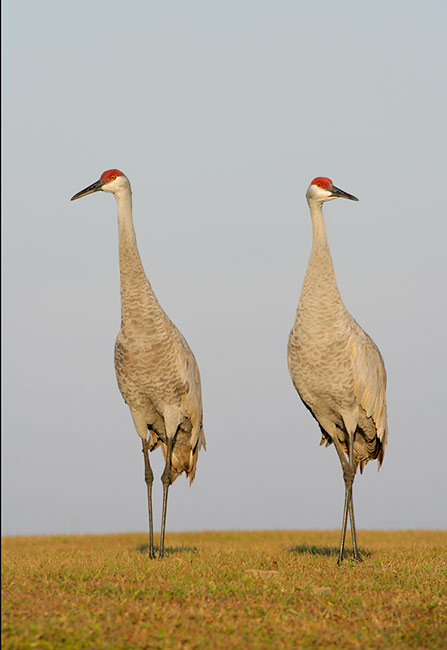
Sandhill Cranes, Indian Lake Estates, FL
The last few
mornings, the local cranes have been nice enough to pose while standing on a
small hill. Here I switched quickly to One-Shot AF to make sure that the AF
system did not start to hunt at the moment of exposure.
eFilm EXPRESS CARD (FOR THE NEWEST LAPTOPS)
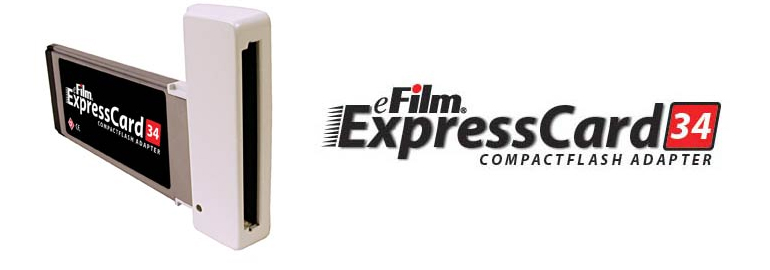
The eFilm ExpressCard 34 enables the fastest data transfer from a Compact Flash memory card to the newest PC laptops and the Apple MacBook Pros with a ExpressCard slots. It works in both the 54 mm and 34 mm ExpressCard slots and can transfer your data up to 20 MB per second. Its small compact size makes it the perfect tool for photographers on the go.
High Speed Transfer: Transfer Speeds - Up to 20 MB per second; Works with MAC and PC; Works in both 34 mm and 54 mm ExpressCard Slots; Plug-and-Play - No drivers required; Hot Swappable; CompactFlash Type I & II Compatible
System Requirements: Laptop or Computer with ExpressCard Slot; Windows XP OR Mac 10.4.x or higher.
Soon to be
Available from BAA Mail Order: eFilm Express Card 34: $59.99 plus $3.00
shipping. .
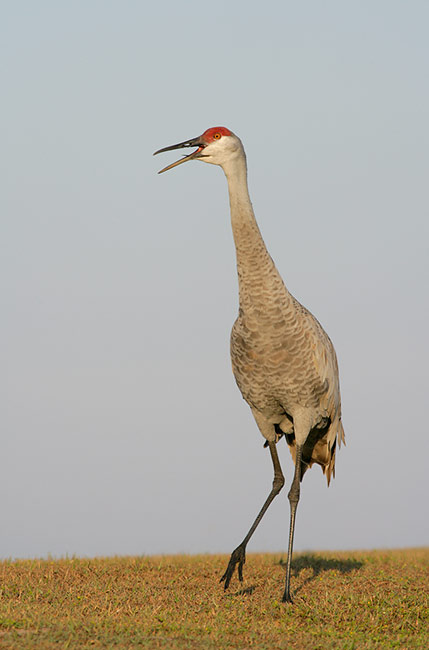
Sandhill Crane calling, Indian Lake Estates, FL
When some neighboring birds fly in, the calling begins.
ICELAND JUNE 2007
If you are interested in joining me in Iceland one way or another in June 2007, click here http://www.birdsasart.com/bn212.htm and then get in touch with me ASAP.
KENYA SEPTEMBER 2008
If you are interested in joining Todd Gustafson and me in Kenya in September 2008, click here http://www.birdsasart.com/bn211.htm and then get in touch with me.
FRANZ LANTING LINK
Franz Lanting is surely one of the giants of modern nature photography. If you are not convinced of that, or if you simply want to see some great images, click here: http://www.lifethroughtime.com/
.
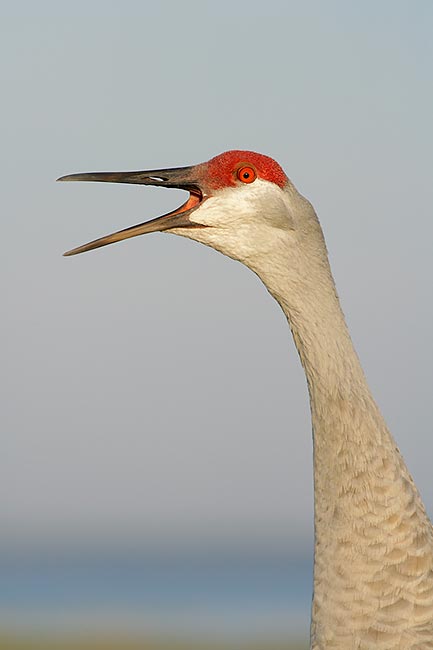
Sandhill Crane calling, Indian Lake Estates, FL
When creating images like this, 45 point AF (AFPS) works perfectly. Note that if I had used the central sensor I could not have created this composition…I added a full stop of light because of the light sky and the somewhat weak early morning sun. See “Exposure Simplified” in ABP II. Note the absolutely perfect head angle.
500 IS LENS COVER
A while back a friend picked up two white plastic container covers for me at Wal-Mart. The covers were a perfect fit for the front of the world’s most popular telephoto lens, the Canon 500mm EF F/4L IS lens. If you would like to try and find one for your 500, here is all of the information that I have: White plastic Corningware cover measuring approximately 5 5/8 inches (14.5cm) in diameter. I believe that the paper label is a Wal-Mart label; the label is on the top of the cover. It says: CORNINGWARE CORELLE-REVERE FACTORY STORES Compare at 1.50. Our price: .99. There are two codes: 30924 50AY and CVR 1607 PL ST RO (or RD—it is hard to tell). On the bottom or inside of the cover the following is embossed: Corning V-16-PC F-16-PC MADE IN USA. COVER FOR REFRIGERATOR, FREEZER, AND MICROWAVE USE. DO NOT USE COVER IN CONVENTIONAL OVEN (DUH!) DISHWASHER TOP RACK ONLY. (You may have to buy the complete container in order to get the cover…)
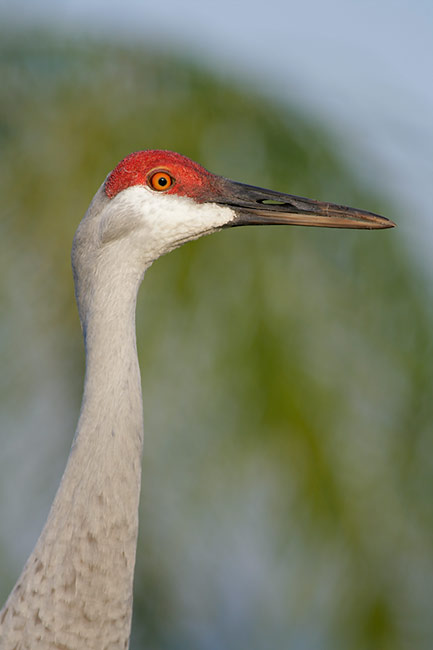
Sandhill Crane, palm tree background, Indian Lake Estates, FL
With the bird right down my shadow line, and a palm tree in the distance, I made a few images with a different and rather pleasing background. Note that with lots of middle green in the background I only needed to add 1/3 stop of light.
BREEZEBROWSER TIP
If you are a serious digital photographer who uses a PC and you are not using Breezebrowser Pro, you are wasting hours each week editing and working with your images. In addition, BreezeBrowser offers high quality, accurate color conversions for images created with all Canon digital cameras.
If you are using Breezebroswer, here is a new tip:
The default settings place each deleted image in the Recycle Bin. If you accidentally delete and image, it can be a real hassle finding it in the recycle bin, especially if there are lots of images there. You can easily change your preferences so that BreezeBrowser will automatically create a Deleted sub-folder and place the deleted images there (rather than in the Recycle Bin).
Here is how to do it:
Click on
File/Preferences and the General tab. (First, I uncheck the confirm before
deleting box ; that allows you to delete single images without having to
confirm by clicking yes in the question dialogue box.)
Then click on Move deleted image to “Deleted” subdirectory. Then click the
OK box at the bottom of the window.
Now, when you delete an image or a series of images, Breezebrowser will—as above—create a Deleted sub-directory and place the deleted image(s) there. After you are finished editing and checking and double checking, you must delete the Deleted subdirectory by right clicking on it and then selecting delete. (If you highlight and delete the images, BB will simply create another Deleted subdirectory…)
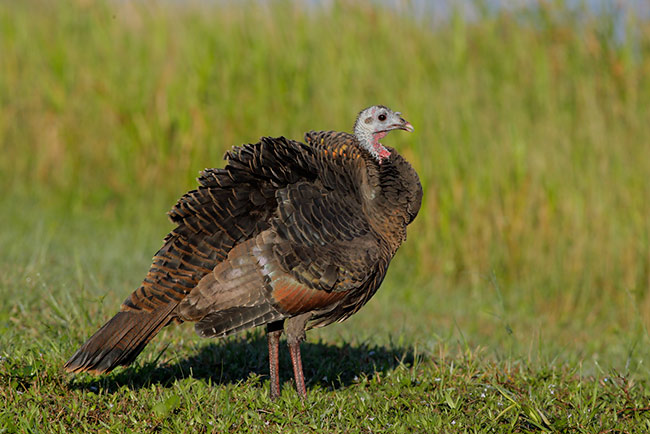
Wild Turkey, young tom (male), Indian Lake Estates, FL
Image copyright 2005: Arthur Morris/BIRDS AS ART
Here I simply metered off the grass and set that exposure manually. This was the equivalent of -1/3 stop as framed above. You need to be careful here not to burn the light blue head.
THANKSGIVING LUNCH
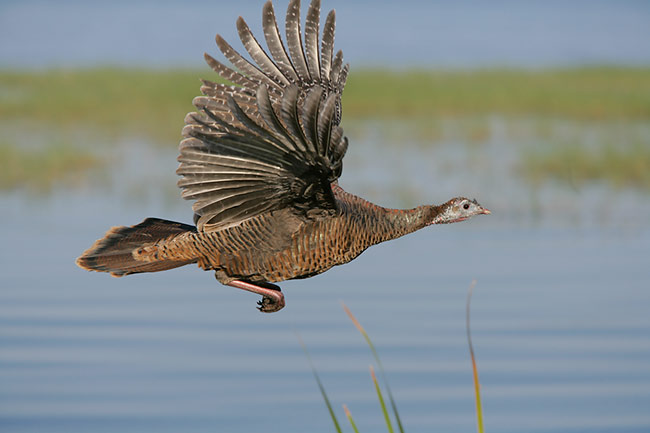
Wild Turkey, immature in flight, Indian Lake Estates, FL
Darn it! I’ve clipped the wing on a spectacular image. What to do? See the next image.
Pat Ford, about a congenial gentleman as you could ever hope to come across, joined us last year on the Fort DeSoto IPT. During the critiquing session folks quickly realized that Pat was a talented photographer. As it turns out, Pat has sold lots of images to various fishing publications. Now, as my good friend Derrick Macdonald (great spring/summer Common Loon photography at Lac-Le-Jeune Resort : http://www.bcfroa.bc.ca/member/88/Lac-Le-Jeune-Resort) can attest, I am among the world’s worst fly casters. But, I was an avid fisherman long before I ever picked up a camera. I ended my fishing career in the late 1970s after landing a 33 pound, 4 ounce striped bass on a blue and white Redfin lure with 10 pound test line off of the Beach 39th Street jetty in Far Rockaway, Queens, NY. In any case, Pat was nice enough to send me a copy of his latest book, “The Best Fly-Fishing Trips Money Can Buy” and I absolutely devoured the book, feasting on the great photography and the great fishing adventures. Pat called upon several of his fishing buddies to do some of the writing, and each of them is legendary in the fishing world. You can find more on Pat’s great book here: The Best Fly-Fishing Trips Money Can Buy.
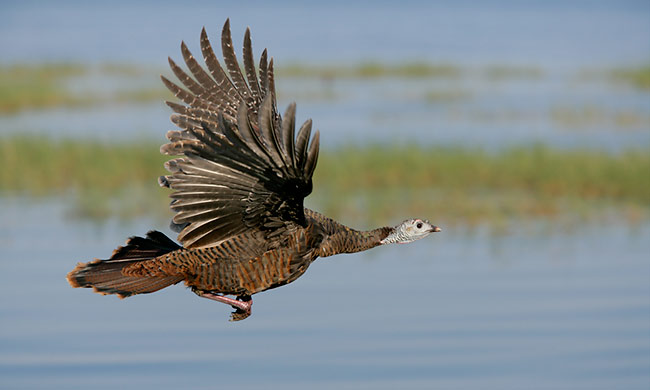
Wild Turkey, immature in flight, Indian Lake Estates, FL
It’s simple. .Expand the canvas and then use the clone tool to first fill in the sky and then rebuild the three clipped primaries. Detailed instructions can be found in our Digital Basics File: http://www.birdsasart.com/digitalbasics.htm.
LegCoatTM TRIPOD LEG COVERS
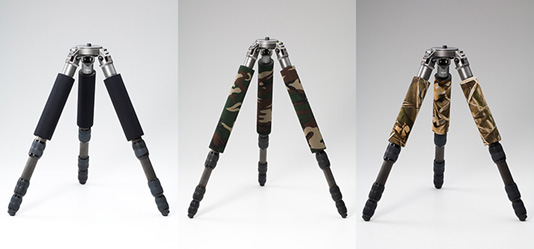
LegCoatTM tripod leg covers protect your shoulders when carrying your gear and the camouflage helps break up the shape of your tripod at the same time.
Made of closed cell foam padding and heavy-duty neoprene, it is soft to the touch but rugged in function. The padding guards your hands from the cold tripod legs in lower temperatures, and can protect the tripod from nicks and scratches.
· Provides all day carrying comfort
· Acts as a thermal barrier- guards hands from hot and cold
· Customized for YOUR tripod - no cutting or fitting required
· 100% heavy-duty neoprene cover
· Made with Velcro® fasteners for easy assembly
· Available in Black, Forest Green Camo, Realtree® Advantage Max4 HD, Realtree® Hardwoods Snow
ALBUQUERQUE
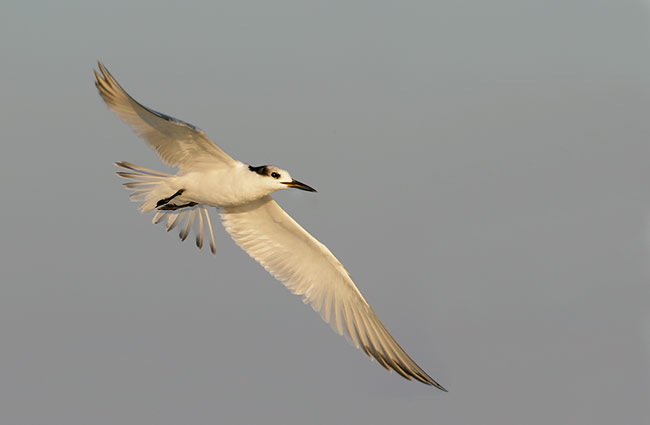
Sandwich Tern, immature in flight, Fort DeSoto Park, nr. St. Petersburg, FL
Do realize that no matter how good your Photoshop skills, JI = JO (junk in equals junk out…) You can check out our Fort DeSoto Site Guide here: http://www.birdsasart.com/siteguides.htm#the%20Fort%20DeSoto/Sarasota%20Site-Guide.
2gb Delkin
e-film Pro Card: $74.98
4gb Delkin
e-film Pro Card: $154.98
8gb Delkin e-film Pro Card: $299.98
Please add
$7.00 per order shipping and handling.
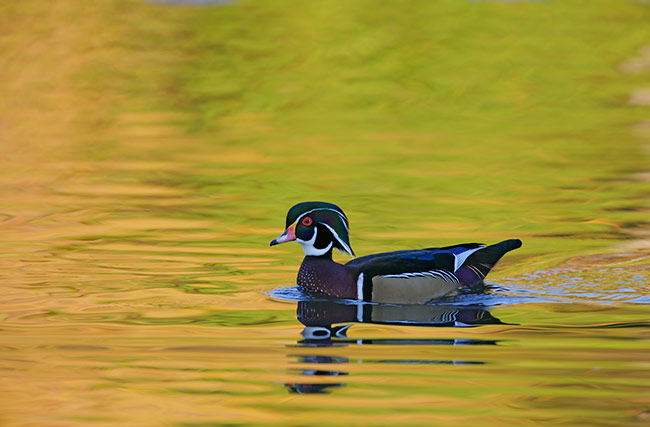
Wood Duck, drake in lime
green reflections, North Chagrin Reservation,
Evaluative Metering +2/3 stop: 1/200 sec. at f/5.6.
Bosque #1: "The Fall Color IPT" NOV 14-16, 2006. 3-DAY: $929. Slide Program
on the evening of NOV 13.
(Two openings.) This
IPT should feature a better chance for a day or two of the rare south winds
that drastically improve flight photography and will definitely feature the
brightest fall-color cottonwoods.
Bosque #2:
"The Pre-Thanksgiving IPT" NOV 19-21, 2006. Slide Program on the evening of
NOV 18. 3-DAY: $929.
(Sold Out.)
This and
the next IPT have sold out for the past eight years. If you are interested in
attending the Thanksgiving Day luncheon in Las Lunas, please contact us via
e-mail. This IPT will feature increasing numbers of geese and cranes with
lots of great opportunities.
Bosque #3:
"The Post-Thanksgiving IPT" NOV 25-27, 2006. 3-DAY: $929. Slide Program on
the evening of NOV 24.
(Sold out.)
This IPT has sold out for the
past eight years as it is scheduled on dates that I consider peak for Bosque.
Bosque #4:
"The Full Moon IPT" DEC 4 (mid-day) through DEC 7 (mid day), 2006. 3-DAY:
$929.
(Sold out.)
Slide Program mid-day on DEC 4.
Co-leaders include Manuel Presti, 2005 Wildlife Photographer of the Year, and
Robert Amoruso. This IPT includes a half day of
photography on the 4th, two full days of photography on the 5th and 6th, and a
final half day on December 7th. Limit 14. This IPT has been scheduled to
maximize the opportunities to include the rising and setting full (DEC 5) and
near-full moon in your images. There will be lots of the usual chances as
well, and this time period has provided more than its share of spectacular
sunrises and sunsets over the years.
SW FLA
Post X-mas IPT: DEC 27-29, 2006. Slide program on the evening of Tuesday, DEC
26. 3 -DAY: $1029. (Limit 12, Openings: 6) Co-leaders:
Alfred Forns, & Robert Amoruso. Sanibel Island, Little Estero Lagoon, Venice
Rookery, Cape Coral. Herons, egrets, gulls, terns, skimmers, shorebirds, both
pelicans, Osprey, Burrowing Owl, and lots more.
Antarctica, JAN 2007: (Sold out.)
Silver Salmon Creek: August 8-14, 2007. Coastal Brown Bears catching salmon, Horned Puffins, macro, scenics, and fishing (optional): $4999. ( Limit 12: openings: 2). Three leaders, two TBA (plus me <smile>.
artie
Note: Arthur Morris has been a Canon contract photographer since 1994 and
continues in that role today. Hunt's Photo of Boston, MA is a BAA sponsor as
it Delkin Devices. Back issues of all BAA Bulletins can be found in
the Bulletin Archives which may be accessed from the home page at
www.birdsasart.com